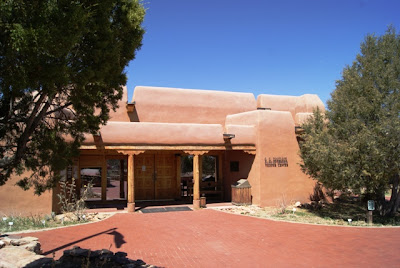Hotel in Santa Fe is designed like the "Pueblo's" of the past.
Interesting works of art are everywhere.
Two mysteries surround the spiral staircase in the Loretto Chapel: the identity of its builder and the physics of its construction.
When the Loretto Chapel was completed in 1878, there was no way to access the choir loft twenty-two feet above. Carpenters were called in to address the problem, but they all concluded access to the loft would have to be via ladder as a staircase would interfere with the interior space of the small Chapel.
Legend says that to find a solution to the seating problem, the Sisters of the Chapel made a novena to St. Joseph, the patron saint of carpenters. On the ninth and final day of prayer, a man appeared at the Chapel with a donkey and a toolbox looking for work. Months later, the elegant circular staircase was completed, and the carpenter disappeared without pay or thanks. After searching for the man (an ad even ran in the local newspaper) and finding no trace of him, some concluded that he was St. Joseph himself, having come in answer to the sisters' prayers.
The stairway's carpenter, whoever he was, built a magnificent structure. The design was innovative for the time and some of the design considerations still perplex experts today.
The staircase has two 360 degree turns and no visible means of support. Also, it is said that the staircase was built without nails—only wooden pegs. Questions also surround the number of stair risers relative to the height of the choir loft and about the types of wood and other materials used in the stairway's construction.
Over the years many have flocked to the Loretto Chapel to see the Miraculous Staircase. The staircase has been the subject of many articles, TV specials, and movies including "Unsolved Mysteries" and the television movie titled "The Staircase."
When the Loretto Chapel was completed in 1878, there was no way to access the choir loft twenty-two feet above. Carpenters were called in to address the problem, but they all concluded access to the loft would have to be via ladder as a staircase would interfere with the interior space of the small Chapel.
Legend says that to find a solution to the seating problem, the Sisters of the Chapel made a novena to St. Joseph, the patron saint of carpenters. On the ninth and final day of prayer, a man appeared at the Chapel with a donkey and a toolbox looking for work. Months later, the elegant circular staircase was completed, and the carpenter disappeared without pay or thanks. After searching for the man (an ad even ran in the local newspaper) and finding no trace of him, some concluded that he was St. Joseph himself, having come in answer to the sisters' prayers.
The stairway's carpenter, whoever he was, built a magnificent structure. The design was innovative for the time and some of the design considerations still perplex experts today.
The staircase has two 360 degree turns and no visible means of support. Also, it is said that the staircase was built without nails—only wooden pegs. Questions also surround the number of stair risers relative to the height of the choir loft and about the types of wood and other materials used in the stairway's construction.
Over the years many have flocked to the Loretto Chapel to see the Miraculous Staircase. The staircase has been the subject of many articles, TV specials, and movies including "Unsolved Mysteries" and the television movie titled "The Staircase."
The Railyard Market sells only organic produce and locally made products.
ART SHOP
The Trailer Ranch RV Park was a great place to stay for two weeks.
The Bumble Bee Baja Grill was a southwest eatery with great meals.
The above Baja Salad was served in a "chalupe bowl".
It is an edible bowl made out of cheese!!!!!
The skies over Santa Fe were unforgettable.





















































